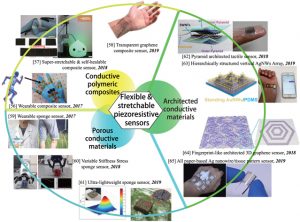Publications
1.
Li, Jing; Fang, Lichen; Sun, Bohan; Li, Xixing; Kang, Sung Hoon
Review—Recent Progress in Flexible and Stretchable Piezoresistive Sensors and Their Applications Journal Article
In: Journal of The Electrochemical Society, 2020.
@article{Li2020,
title = {Review—Recent Progress in Flexible and Stretchable Piezoresistive Sensors and Their Applications},
author = {Jing Li and Lichen Fang and Bohan Sun and Xixing Li and Sung Hoon Kang},
url = {https://iopscience.iop.org/article/10.1149/1945-7111/ab6828},
doi = {https://doi.org/10.1149/1945-7111/ab6828},
year = {2020},
date = {2020-02-03},
journal = {Journal of The Electrochemical Society},
abstract = {The recent advances in wearable electronics and intelligent human-machine interface systems have garnered great interests in electromechanical sensors, which can measure and quantify physical stimuli. Among different types of electromechanical sensors, piezoresistive sensors have been extensively investigated due to the excellent sensitivity, simple construction, and durability. Especially, there have been remarkable developments of flexible and stretchable piezoresistive sensors for wearable devices by investigating novel material/structural strategies to obtain highly sensitive piezoresistive sensors with skin-like flexibility. Here, we give a comprehensive overview of the recent progress in flexible and stretchable piezoresistive sensors and their applications. Based on the material composition and structural characteristics, the piezoresistive sensors are categorized into three types—conductive polymeric composite, porous conductive material, and architected conductive material. Subsequently, we have summarized their transduction mechanisms, fabrication processes, sensing performances, and applications. Finally, we have discussed current challenges and future opportunities for piezoresistive sensors.},
keywords = {},
pubstate = {published},
tppubtype = {article}
}
The recent advances in wearable electronics and intelligent human-machine interface systems have garnered great interests in electromechanical sensors, which can measure and quantify physical stimuli. Among different types of electromechanical sensors, piezoresistive sensors have been extensively investigated due to the excellent sensitivity, simple construction, and durability. Especially, there have been remarkable developments of flexible and stretchable piezoresistive sensors for wearable devices by investigating novel material/structural strategies to obtain highly sensitive piezoresistive sensors with skin-like flexibility. Here, we give a comprehensive overview of the recent progress in flexible and stretchable piezoresistive sensors and their applications. Based on the material composition and structural characteristics, the piezoresistive sensors are categorized into three types—conductive polymeric composite, porous conductive material, and architected conductive material. Subsequently, we have summarized their transduction mechanisms, fabrication processes, sensing performances, and applications. Finally, we have discussed current challenges and future opportunities for piezoresistive sensors.
Note: Send e-mail to Prof. Kang at shkang@jhu.edu if you need a pdf file of the papers below.
2020

Li, Jing; Fang, Lichen; Sun, Bohan; Li, Xixing; Kang, Sung Hoon
Review—Recent Progress in Flexible and Stretchable Piezoresistive Sensors and Their Applications Journal Article
In: Journal of The Electrochemical Society, 2020.
Abstract | Links | BibTeX | Tags: Piezoresistive Sensors
@article{Li2020,
title = {Review—Recent Progress in Flexible and Stretchable Piezoresistive Sensors and Their Applications},
author = {Jing Li and Lichen Fang and Bohan Sun and Xixing Li and Sung Hoon Kang},
url = {https://iopscience.iop.org/article/10.1149/1945-7111/ab6828},
doi = {https://doi.org/10.1149/1945-7111/ab6828},
year = {2020},
date = {2020-02-03},
journal = {Journal of The Electrochemical Society},
abstract = {The recent advances in wearable electronics and intelligent human-machine interface systems have garnered great interests in electromechanical sensors, which can measure and quantify physical stimuli. Among different types of electromechanical sensors, piezoresistive sensors have been extensively investigated due to the excellent sensitivity, simple construction, and durability. Especially, there have been remarkable developments of flexible and stretchable piezoresistive sensors for wearable devices by investigating novel material/structural strategies to obtain highly sensitive piezoresistive sensors with skin-like flexibility. Here, we give a comprehensive overview of the recent progress in flexible and stretchable piezoresistive sensors and their applications. Based on the material composition and structural characteristics, the piezoresistive sensors are categorized into three types—conductive polymeric composite, porous conductive material, and architected conductive material. Subsequently, we have summarized their transduction mechanisms, fabrication processes, sensing performances, and applications. Finally, we have discussed current challenges and future opportunities for piezoresistive sensors.},
keywords = {Piezoresistive Sensors},
pubstate = {published},
tppubtype = {article}
}
The recent advances in wearable electronics and intelligent human-machine interface systems have garnered great interests in electromechanical sensors, which can measure and quantify physical stimuli. Among different types of electromechanical sensors, piezoresistive sensors have been extensively investigated due to the excellent sensitivity, simple construction, and durability. Especially, there have been remarkable developments of flexible and stretchable piezoresistive sensors for wearable devices by investigating novel material/structural strategies to obtain highly sensitive piezoresistive sensors with skin-like flexibility. Here, we give a comprehensive overview of the recent progress in flexible and stretchable piezoresistive sensors and their applications. Based on the material composition and structural characteristics, the piezoresistive sensors are categorized into three types—conductive polymeric composite, porous conductive material, and architected conductive material. Subsequently, we have summarized their transduction mechanisms, fabrication processes, sensing performances, and applications. Finally, we have discussed current challenges and future opportunities for piezoresistive sensors.